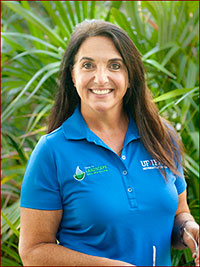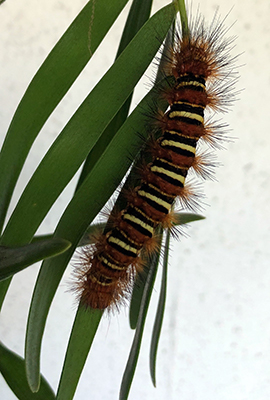Wendy's Wanderings
August 13, 2020
Coontie
Like so many Florida gardeners, I am in love with coontie, Zamia pumila. This Florida native cycad is a workhorse in the landscape. As an evergreen that grows 2 to 3 feet tall in clumps, it fills a niche in the Florida-Friendly landscape. It grows easily in many different soil types and performs well in both sun and in shade.
Recently I dropped my daughter back off at college in Deland. Stetson University has extensive native plantings and utilizes coontie in many of their landscape beds. I was admiring how well they were doing when I noticed that I was not the only one loving the coontie.
My eyes went wide with shock to see a big, 3-inch long, fuzzy orange caterpillar with yellow bands edged in black, munching away on the coontie's pinnate leaves. It was an echo moth caterpillar, looking quite robust.

One of the echo moth caterpillars
Wendy saw on the coontie.
You don't often see a caterpillar feeding on coontie except the endangered Atala hairstreak that ranges farther south in Florida. Further search of the plants revealed only four more echo moth caterpillars and not much damage from them. In fact I could see very little chewing damage at all. The moth of these caterpillars is about quarter sized and white with greenish-gold wing veins. Echo moth caterpillars are also known to feed on oak or persimmon leaves.
We don't often think of coontie as a butterfly and moth host plant, but it can be and certainly would have a place in your butterfly garden.
-- Wendy Wilber
Learn More

